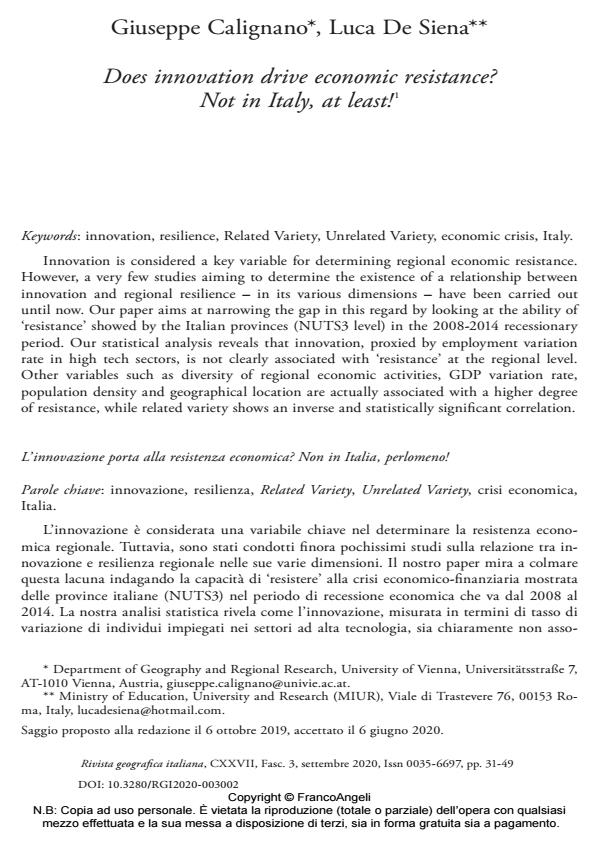Does innovation drive economic resistance? Not in Italy, at least!
Titolo Rivista RIVISTA GEOGRAFICA ITALIANA
Autori/Curatori Giuseppe Calignano, Luca De Siena
Anno di pubblicazione 2020 Fascicolo 2020/3
Lingua Inglese Numero pagine 19 P. 31-49 Dimensione file 163 KB
DOI 10.3280/RGI2020-003002
Il DOI è il codice a barre della proprietà intellettuale: per saperne di più
clicca qui
Qui sotto puoi vedere in anteprima la prima pagina di questo articolo.
Se questo articolo ti interessa, lo puoi acquistare (e scaricare in formato pdf) seguendo le facili indicazioni per acquistare il download credit. Acquista Download Credits per scaricare questo Articolo in formato PDF

FrancoAngeli è membro della Publishers International Linking Association, Inc (PILA)associazione indipendente e non profit per facilitare (attraverso i servizi tecnologici implementati da CrossRef.org) l’accesso degli studiosi ai contenuti digitali nelle pubblicazioni professionali e scientifiche
Innovation is considered a key variable for determining regional economic resistance. However, a very few studies aiming to determine the existence of a relationship between innovation and regional resilience - in its various dimensions - have been carried out until now. Our paper aims at narrowing the gap in this regard by looking at the ability of ‘resistance’ showed by the Italian provinces (NUTS3 level) in the 2008-2014 recessionary period. Our statistical analysis reveals that innovation, proxied by employment variation rate in high tech sectors, is not clearly associated with ‘resistance’ at the regional level. Other variables such as diversity of regional economic activities, GDP variation rate, population density and geographical location are actually associated with a higher degree of resistance, while related variety shows an inverse and statistically significant correlation.
L’innovazione e considerata una variabile chiave nel determinare la resistenza economica regionale. Tuttavia, sono stati condotti finora pochissimi studi sulla relazione tra innovazione e resilienza regionale nelle sue varie dimensioni. Il nostro paper mira a colmare questa lacuna indagando la capacita di ‘resistere’ alla crisi economico-finanziaria mostrata delle province italiane (NUTS3) nel periodo di recessione economica che va dal 2008 al 2014. La nostra analisi statistica rivela come l’innovazione, misurata in termini di tasso di variazione di individui impiegati nei settori ad alta tecnologia, sia chiaramente non asso ciata alla ‘resistenza’ a livello regionale. Altre variabili come un’elevata diversita di attivita economiche a livello regionale, il tasso di variazione del Prodotto Interno Lordo, la densita della popolazione e la posizione geografica sono effettivamente associate ad un piu alto grado di resistenza, mentre la related variety mostra una correlazione inversa e statisticamente significativa.
Parole chiave:Innovazione, resilienza, Related Variety, Unrelated Variety, crisi economica, Italia.
- From Adversity to Advantage: A Systematic Literature Review on Regional Economic Resilience Mantas Rimidis, Mindaugas Butkus, in Urban Science /2025 pp.118
DOI: 10.3390/urbansci9040118 - Knowledge and innovation dynamics of the Northwest Russia under geopolitical changes A. S. Mikhaylov, D. D. Maksimenko , M. R. Maksimenko , M. M. Filatov , in Baltic Region /2023 pp.79
DOI: 10.5922/2079-8555-2023-4-5 - A inovação pode prever a resiliência regional? Uma exploração econométrica dos municípios brasileiros durante a pandemia de COVID-19 Luiz Fernando Câmara Viana, Valmir Emil Hoffmann, Hugo Pinto, in International Journal of Innovation e24738/2024 pp.1
DOI: 10.5585/2024.24738
Giuseppe Calignano, Luca De Siena, Does innovation drive economic resistance? Not in Italy, at least! in "RIVISTA GEOGRAFICA ITALIANA" 3/2020, pp 31-49, DOI: 10.3280/RGI2020-003002